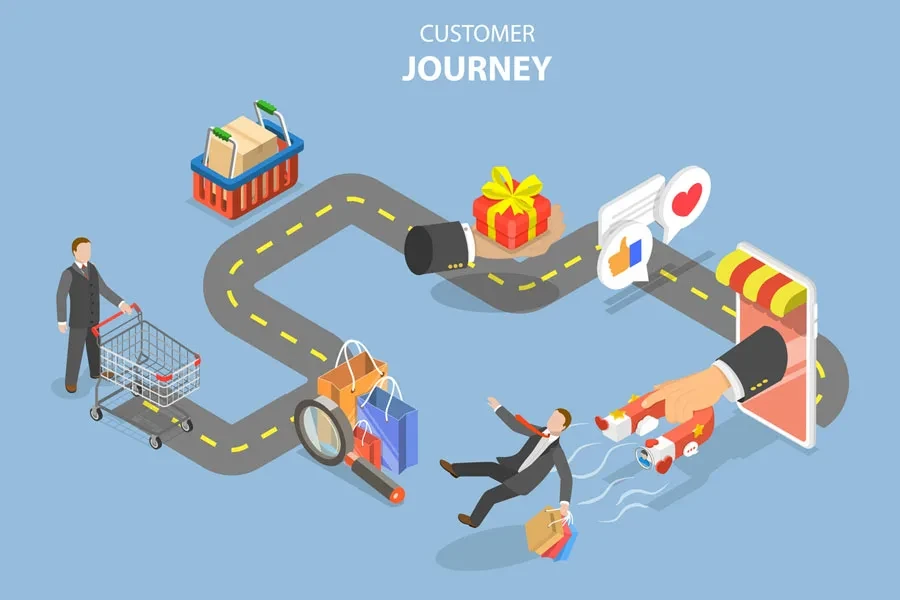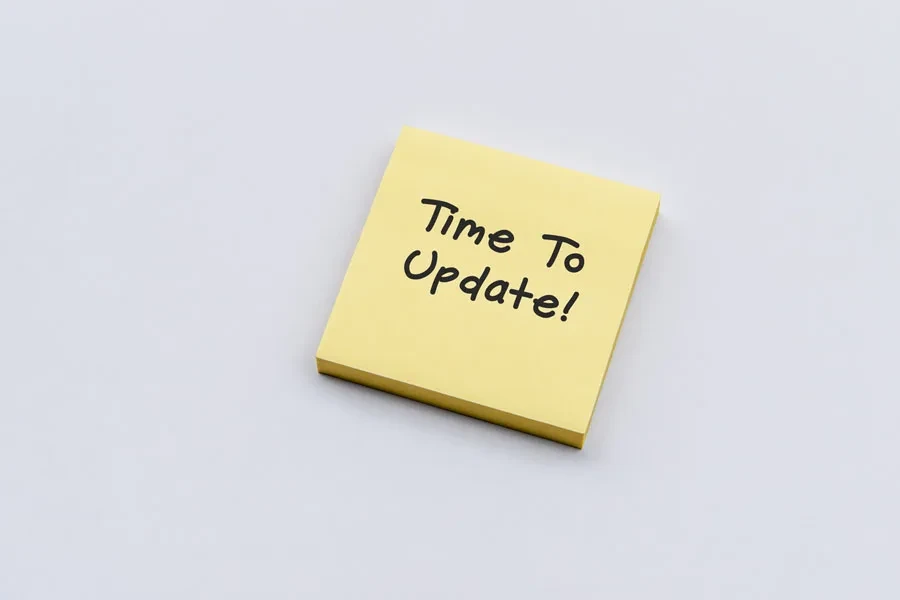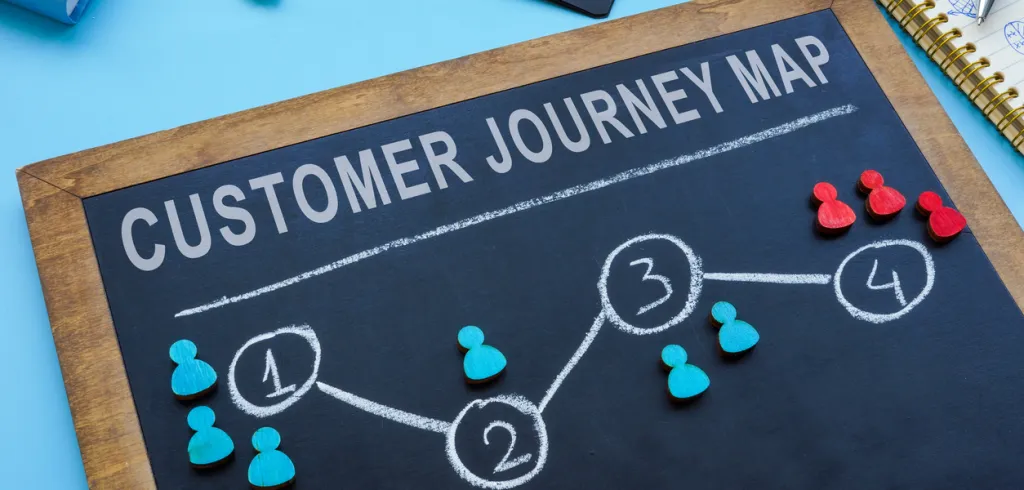Understanding your customers’ journeys can be challenging. Every user has a distinct reason for engaging with your business and a unique path to access your online pages before eventually buying your products.
Therefore, how can you ensure that you gain valuable insights about your customers to improve their user experience and understand their purchasing habits? Through creating customer journey maps. This guide will explore what a customer journey map entails and give you the steps to create one. Keep reading to learn more.
Table of Contents
What is a customer journey map?
Steps for creating a customer journey map
Conclusion
What is a customer journey map?

A customer journey visually represents the customer’s interaction with a company, highlighting their experience from initial contact to post-purchase support. It provides valuable insights into potential customers’ needs and desires at each journey stage, as well as the factors that either facilitate or hinder their progression.
Mapping out this journey helps you better understand your customers’ perspectives, identify pain points, and optimize touchpoints to enhance their overall customer experience, boosting customer satisfaction and loyalty.
How to create a customer journey map
Creating a customer journey map requires meticulously following a series of steps. Here are the steps you should follow when crafting the map:
1. Use customer journey templates

Instead of starting from scratch, you can leverage tried-and-tested customer journey templates that many entrepreneurs have adopted globally. These templates can assist your sales and marketing reps and your support team learn more about your customers’ personas, ultimately leading to improved products and better customer experiences.
There are different types of customer journey templates that you can choose from. However, picking a template will entirely depend on what type of goals you have. These templates are as follows:
Current state template
The current state is the most popular template, which examines customers’ current actions, thoughts, and emotions during interactions with your business. It identifies pain points well and effectively guides incremental changes to enhance the overall customer experience.
| Customer journey: Current state | Step 1 | Step 2 | Step 3 | Step 4 | Step 5 |
| What is the customer thinking or feeling? | |||||
| What is the customer’s action? | |||||
| What is the customer’s touchpoint with the business? | |||||
| What do we want to change about this step? | |||||
| How and/or why will we make this change? |
Future state template
The future state template directs attention to customers’ anticipated actions, thoughts, and emotions in upcoming interactions. It proves valuable for illustrating how customers will respond to new products, services, and experiences, providing a clear picture for planning and implementing strategies aligned with future expectations.
| Customer journey: Future state | Step 1 | Step 2 | Step 3 | Step 4 | Step 5 |
| What is the customer thinking or feeling? | |||||
| What is the customer’s action? | |||||
| What is the customer’s touchpoint with the business? | |||||
| What do we want to change about this step? | |||||
| How and/or why will we make this change? |
Day-in-the-life template
The day-in-the-life customer journey map template imitates the current state template, capturing current customer behaviors, thoughts, and emotions. However, it goes beyond individual interactions with your brand, exploring how customers engage with peers in the area.
This template works best for inspiring new initiatives and identifying unfulfilled needs in the market.
| Customer journey: A Day in the Life | Early morning | Late morning | Afternoon | Early evening | Night time |
| What is the customer thinking or feeling? | |||||
| What are the customer’s actions or main priorities? | |||||
| What are the customer’s touchpoints at this time? | |||||
| How is the customer interacting with our product at this time? | |||||
| How can the customer better utilize our product at this time? |
Service blueprint template
This template starts with a condensed version of a current or future state journey map, consisting of a network of individuals, methodologies, processes, and technologies integral to delivering a streamlined, present- or future-oriented customer experience.
While current state blueprints pinpoint existing pain points, aiding in problem identification, future state blueprints assist in creating an environment essential for a planned customer experience.
| Customer journey: Service and support | Normal use | Notices issue or has a complaint | Asks for help/contacts support | Speaks with support or rep | Resolves conflict or issue |
| What is the customer thinking or feeling? | |||||
| Why is the customer feeling this way? | |||||
| How do we communicate with the customer? | |||||
| What action do we take in the background? |
2. Set clear objectives for the map

When creating a fresh customer journey map, clearly defining your objectives is vital. Whether it’s improving overall customer satisfaction or targeting specific issues like reducing complaints about late deliveries, understanding your goals helps determine which touchpoints to map.
A broad objective may necessitate mapping the entire customer experience, spanning multiple journey maps. However, a specific objective allows for a more focused approach, concentrating efforts on particular areas of the organization, like the warehouse, delivery, and customer service departments.
3. Gather information

Once you have set your goals for the map, the next step is to collect information. This is because to understand why customers engage with your organization, you need to look into what motivates them, their preferences, and their behaviors.
You can employ various research methods, including market research, focus groups, surveys, analytics, and interviews, to collect customer information. These tools provide valuable insights into customer interactions, the timing and duration of these engagements, and the expectations they bring to the experience.
The information you have will help you create buyer personas (a fictional representation of your ideal customer based on research and data that will guide targeted marketing efforts), which aids in acknowledging the specific customer needs and preferences.
4. Identify your customer touchpoints

Customers engage with your brand through diverse touchpoints, including in-store activities, online searches, social media, telephone calls, blogs, help desks, email campaigns, online chat services, conferences, product demonstrations, and sales calls.
Once you have identified these touchpoints, consider how they impact your customers. For instance, if something goes wrong, who do they contact? Where can people look up delivery-related information? Is it simple for them to obtain your contact information?
Despite having an excellent customer service team ready to answer questions, if your sales team or website provides inconsistent or inaccurate information, your customers may not receive excellent service—instead, they will be left confused.
5. Understand your available resources

After identifying touchpoints, determining your available resources and the ones you’ll need follows.
Your customer journey map touches nearly every part of your business, highlighting all the resources involved in crafting the customer experience. For instance, if your map reveals that your team lacks the necessary tools to follow up with customers, you can use it to recommend investing in customer service tools. Help desk ticketing, CRM, live chat, reporting dashboards, and email management software are commonly used customer service tools.
By incorporating these tools into your map, you can forecast their impact on your business, i.e., boosting your sales or increasing your ROI.
6. Take the customer journey yourself

To enhance the effectiveness of creating a customer journey map, it is crucial to personally experience the process outlined in the map. This involves putting yourself in the customer’s shoes, allowing you to gain invaluable insights into potential challenges and pain points.
This hands-on approach transforms theoretical concepts into practical observations, revealing areas for improvement or optimization. You can engage with various touchpoints like social media, emails, and online searches, which will help you identify friction points and gauge the overall customer experience. Ultimately, it enables you to refine your strategies, enhancing satisfaction and loyalty.
7. Analyze results

After designing and testing your map, an important step involves analyzing the outcomes. Your completed map should be able to answer questions like, What prompts users to exit your website without completing a purchase? How can customer support be enhanced?
Analyzing the findings will tell you where client needs aren’t being met. And if something might have been missed, there is room for improvement. This way, you can ensure that you’re offering a worthwhile experience while assuring your customers that you can solve their problems with help from your company.
8. Update your map over time

Regularly revisit and update your customer journey map as your website evolves to ensure it aligns with user needs and goals. Additionally, analyze the data to provide insights into desired website improvements.
Whether it’s refining call-to-action links or enhancing product descriptions, the changes should directly address customer pain points identified through data analysis. These updates are effective regardless of how you scale, as they cater to your customers’ needs.
By visualizing the customer journey map, you clearly understand user experiences, ensuring continuous alignment between website changes and customer expectations over time.
Conclusion
When you become aware of how customers feel about your business, you can satisfy them at every step of their buying journey. Don’t forget that many things can change this journey, like customer pain points, their feelings, and how your company does things.
A customer journey map is the best way to see all this information. Whether you want to improve the customer experience or find new ways to help customers, this guide can help you plan for future success at your business.





 Afrikaans
Afrikaans አማርኛ
አማርኛ العربية
العربية বাংলা
বাংলা Nederlands
Nederlands English
English Français
Français Deutsch
Deutsch हिन्दी
हिन्दी Bahasa Indonesia
Bahasa Indonesia Italiano
Italiano 日本語
日本語 한국어
한국어 Bahasa Melayu
Bahasa Melayu മലയാളം
മലയാളം پښتو
پښتو فارسی
فارسی Polski
Polski Português
Português Русский
Русский Español
Español Kiswahili
Kiswahili ไทย
ไทย Türkçe
Türkçe اردو
اردو Tiếng Việt
Tiếng Việt isiXhosa
isiXhosa Zulu
Zulu